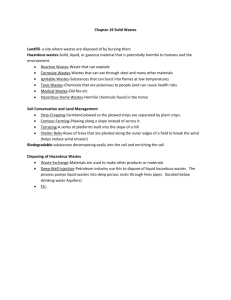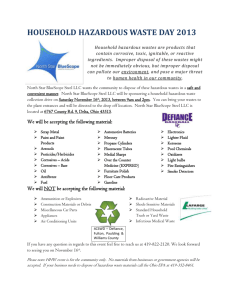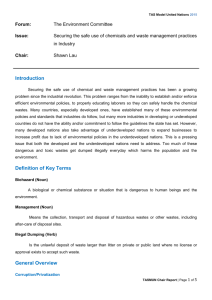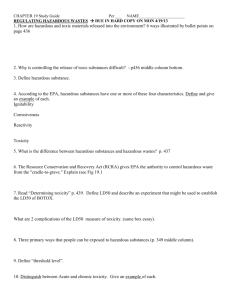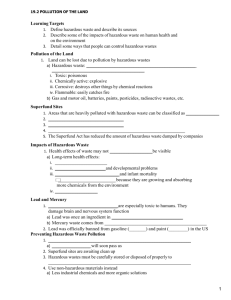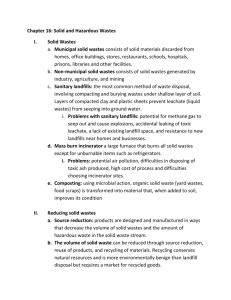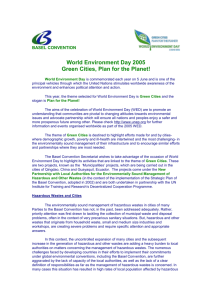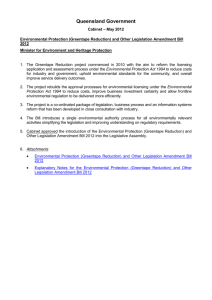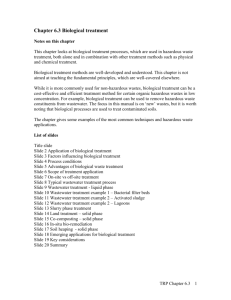Japan - Basel Convention
advertisement
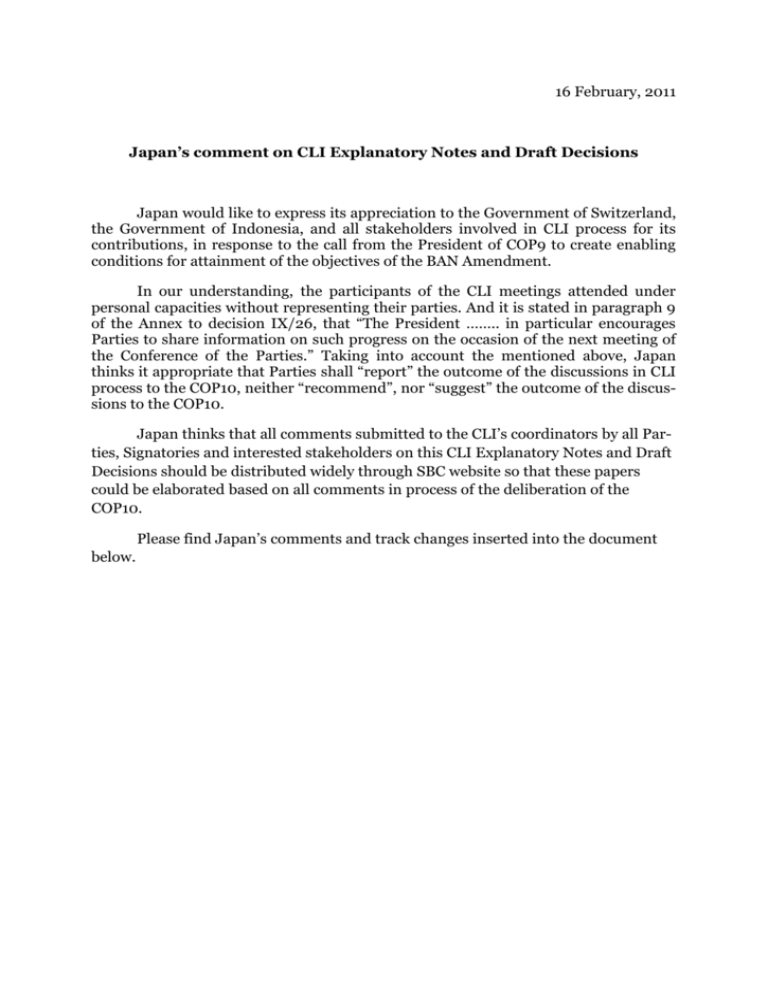
16 February, 2011 Japan’s comment on CLI Explanatory Notes and Draft Decisions Japan would like to express its appreciation to the Government of Switzerland, the Government of Indonesia, and all stakeholders involved in CLI process for its contributions, in response to the call from the President of COP9 to create enabling conditions for attainment of the objectives of the BAN Amendment. In our understanding, the participants of the CLI meetings attended under personal capacities without representing their parties. And it is stated in paragraph 9 of the Annex to decision IX/26, that “The President …….. in particular encourages Parties to share information on such progress on the occasion of the next meeting of the Conference of the Parties.” Taking into account the mentioned above, Japan thinks it appropriate that Parties shall “report” the outcome of the discussions in CLI process to the COP10, neither “recommend”, nor “suggest” the outcome of the discussions to the COP10. Japan thinks that all comments submitted to the CLI’s coordinators by all Parties, Signatories and interested stakeholders on this CLI Explanatory Notes and Draft Decisions should be distributed widely through SBC website so that these papers could be elaborated based on all comments in process of the deliberation of the COP10. Please find Japan’s comments and track changes inserted into the document below. CLI/2010/3/2 Basel Convention Indonesian-Swiss Country-Led Initiative (CLI) to improve the effectiveness of the Basel Convention Explanatory note Introduction The Indonesian-Swiss Country-Led Initiative (CLI) process was initiated by Indonesia and Switzerland in response to a statement made by the President of the Ninth Meeting of the Conference of the Parties to the Basel Convention1. The President encouraged Parties to explore ways of furthering the objectives of the Ban Amendment. The Ban Amendment (Annex 1) is an important instrument to protect vulnerable countries against adverse effects of imports of hazardous wastes they cannot handle in an environmentally sound manner and should enter into force. It divides the Parties to the Basel Convention into two groups, the first of which comprises of OECD and EU member countries as well as Liechtenstein; the second, all other countries. The Amendment prohibits movements of hazardous wastes from the first group of Parties who have ratified the Amendment to the second group. This includes movement for any sort of disposal, whether final disposal or recycling/recovery. Although the ban was adopted as a decision at the first meeting of the Conference of the Parties in 1992 and subsequently adopted as an amendment to the Convention at the third meeting 15 years ago, it still has not entered into force. Thus, there are two possible approaches to furthering the objectives of the Ban Amendment as requested by the President’s statement: to find a possible way forward on the Ban Amendment and to find other ways of protecting vulnerable countries. The CLI concluded that both these approaches are needed. The CLI process 1 Annex to Decision IX/26: President’s statement on the possible way forward on the Ban Amendment The two lead countries to the CLI invited experts from a number of Parties to participate in the process. The range of participation was selected from Annex VII and non-Annex VII Parties, and was intended to reflect the range of political positions on the Ban Amendment as well as being drawn from across the various United Nations geographic regions. Three meetings were held to hear and consider evidence about flows of hazardous wastes, the reasons for those flows and the harm caused by inadequate management of the wastes. Each meeting lasted 4 or 5 days, was residential and held in a remote resort, to encourage participants to immerse themselves in the process. The participants were invited to discuss the issue in a pragmatic way, without taking a political stance. Chatham House rules prevailed, so that participants could speak frankly without attribution. The outcomes of the meetings were a series of papers that were placed on the Basel Convention website for public consultation. Responses to the consultations were also published (where the author gave permission) and were referred to in revising the documents. Additionally, the outcomes of the first and second meetings were presented to and discussed by the Open Ended Working Group of the Basel Convention during its seventh session (10-14 May 2010). Therefore, even though the participation in the meetings was limited, the CLI was a transparent process. This document reflects the outcome of the third meeting, which takes the form of a draft omnibus decision composed of seven sections to be presented for consideration by the tenth meeting of the Conference of the Parties. This draft decision shall be subject to consultation and discussion, at first between participants in the CLI process but then opening up to all Parties and interested stakeholders. The draft omnibus decision emanating from the third meeting deals with both the approaches to meeting the objectives of the Ban Amendment: expediting ratification of the Ban Amendment; and other ways of meeting the Ban’s objectives. Promoting entry into force At the time of drafting this Explanatory Note, 68 Parties have ratified the Amendment. Depending on how the Convention’s provision on entry into force of amendments is interpreted, the Ban Amendment may therefore still require ratification by a large number of Parties before it enters into force. There are different reasons why many Parties may not be in a position to ratify the Ban Amendment. Some countries find it difficult to implement the necessary legislation or other measures necessary to ratify the amendment. Some Annex VII countries lack the necessary facilities for recycling certain wastes in their own country and find that an effective and efficient solution, consistent with the proximity principle, is to have the waste treated in environmentally sound facilities in nearby nonAnnex VII countries. Some non-Annex VII countries rely on such imports as important sources of raw materials. In some regions, there are important collaborations between countries, using investment by an Annex VII country to promote improved environmentally sound waste management in nearby non-Annex VII countries. The CLI identified a number of measures that could be brought forward to assist the first group of Parties – those who lack the resources or institutional capacity to pro- pose and implement legislative or regulatory instruments to implement the Ban Amendment. For the others, though, it was recognised that these countries would be unlikely to ratify the Amendment even if it should enter into force. Considering that the Parties to the Convention have the ultimate power to agree on the interpretation of the Convention, some of the members of the CLI has proposed adopting a ‘fixed-time’ approach for amendments to the Convention to enter into force. This approach would use the number of parties to the Convention at the time that the Amendment was adopted as the basis for entry into force. The CLI considered the consequences of entry into force of the Amendment. Regardless of whether the Amendment was in force or not, Annex VII countries that have ratified the Amendment can commit themselves to not export hazardous wastes to non-Annex VII countries – in fact many Annex VII countries that have already ratified the Amendment have also adopted legislation in line with the terms of the Ban. In the event Annex VII countries did not wish to ratify the Amendment, they would not be bound by it once it entered into force, provided they were a Party to the Convention prior to its entry into force. Following entry into force of the amendment, non-Annex VII countries will be expected not to receive any hazardous wastes from Annex VII countries that have ratified the Amendment. As indicated, in the light of the current policy of Annex VII countries that have ratified the Amendment to implement the ban already before its entry into force, the entry into force of the Amendment would primarily formalize internationally the current situation. Ratification of the Ban would not affect imports from other non-Annex VII countries. Therefore, to secure wider protection the countries would have to take active steps, e.g. via import bans in national legislation to prohibit imports from non-Annex VII countries, as provided by the Convention. It was concluded that while entry into force of the Amendment would send a powerful political signal, there would be no practical implications. The only difference to the current situation would be that more Parties have ratified the Ban and thus the number of Parties applying the Ban would have increased. This situation is visualised in the graphic below. Situation of transboundary movements of hazardous waste (TBM) among Parties: Ban amendment in force or not in force TBM TBM Annex VII Parties, Ban ratified TBM TB M Annex VII Parties, Ban not ratified TBM TBM M TB TBM TBM Non- AnnexVII Parties, Ban ratified TBM Non-Annex VII Parties, Ban not ratified Other measures In spite of the steps taken to promote the Amendment’s entry into force this is unlikely to happen in the near future, and when it does enter into force many countries will continue to choose not to ratify it. The Ban Amendment can, at best, be only a partial solution to protect vulnerable countries and other measures are therefore necessary to further its objective. Broader measures are also important because the world has changed considerably over the last 15 years since the adoption of the Ban Amendment. Generation of hazardous wastes is increasingly a problem in developing countries. Transboundary movements of hazardous wastes from non-Annex VII countries to other non-Annex VII countries and treatment of domestically-generated hazardous wastes are therefore increasingly relevant. Also illegal traffic of hazardous wastes is a large problem. Zeichenblatt 1 None of these issues would be addressed by the entry into force of the Ban Amendment. For these reasons, the CLI has considered other ways of furthering the objective of the Ban Amendment - the protection of vulnerable countries. It has made recommendations about improving the ways hazardous wastes are dealt with, through the promotion of a framework of requirements for environmentally sound management (ESM)2, recommendations about legal clarity and combating illegal traffic, recommendations for action at regional level and ways of assisting countries to build upon and utilise their rights to prohibit the import of hazardous wastes, from whatever source. The CLI also recognised that financing, expertise and technology would have to be found for such initiatives, and has proposed methods for raising awareness of the Convention’s work and forging links with other initiatives. The CLI’s recommendations The outcome of the CLI process is a paper, currently in draft form, intended ultimately for presentation to the tenth meeting of the Conference of the Parties (COP) in October 2011. This paper sets out a number of recommendations in the form of an omnibus draft decision for consideration by the COP. This decision is a compilation from a number of elements identified during the second meeting of the CLI and presented to the seventh session of the Open Ended Working Group (OEWG-7) in May 2010, which took note of the list of elements for inclusion in a possible way forward. The following elements were identified: Addressing the entry into force of the Amendment Following comments received at OEWG-7 this element was given greater priority, not least because of its political importance. Countries are encouraged to ratify the Amendment and would be assisted through regional cooperation and specific initiatives. An agreed interpretation of paragraph 5 of article 17 - the provision of the Convention relating to the entry into force of amendments - so as to allow an early entry into force of the Ban Amendment is also recommended Development of a Framework of Requirements for Environmentally Sound Management The draft decision recommends that an expert technical group be established, taking into account regional balance to be mandated to further disseminate existing work, develop a new framework on ESM and investigate ways in which ESM standards might be linked to transboundary movements of hazardous wastes. 2 ESM – environmentally sound management: taking all practicable steps to ensure that hazardous wastes or other wastes are managed in a manner which will protect human health and the environment from the adverse effects which may result from such wastes Providing further legal clarity CLI participants have identified a number of areas where the wording of the Convention, or its on-the-ground interpretation, is not clear or differs between countries. The CLI is recommending that work be undertaken within the Basel Convention Committee for Administering the Mechanism for Promoting Implementation and Compliance to provide additional clarity in this respect. Recognising the important role of the Basel Convention Regional Centres Many of the recommendations in the draft decision would be best implemented at regional level. For this reason, the COP is invited to recognise this, to enhance and further support the work of the Centres, including integrating this role into the BCRCs development within the new strategic framework for the Basel Convention. Combating illegal traffic more effectively The CLI heard evidence that illegal traffic in hazardous wastes is causing considerable harm to human health and the environment. Clearly, better enforcement is essential to addressing this issue. Enforcement authorities already cooperate with each other in a number of ways, and the CLI recommends that this work is built upon, promulgated and encouraged in a number of specific ways. Assisting vulnerable countries to prohibit the import of hazardous wastes The Convention provides for Parties to prohibit imports of hazardous wastes and a mechanism is provided to enable notification of such prohibitions. Some countries have, however, faced practical obstacles to taking the necessary steps to implement such prohibitions. The draft decision identifies a number of steps that might be taken by the Secretariat, by regional centres and by Parties to assist overcome these obstacles. Building Capacity In many parts of the world there would be severe difficulties in finding the resources necessary to support a drive towards the improved environmentally sound waste management envisaged in the above mentioned elements. Thus, capacity building will need to be a priority in any such initiative implementing the draft decision. The CLI has identified a number of elements that might contribute to capacity building. In this context it is important to recognise that the resources that would be needed include not just financial resources but also expertise, knowledge and technology transfer. An important first step would be to link and integrate the goals of the Convention with other important initiatives, such as the Millennium Development Goals, climate change, human health initiatives and so on. Securing political and public engagement is also necessary. At present, the data on the problems caused by inadequate management of hazardous waste is sparse when compared to the data relating to other health and environmental problems, such as water pollution, desertification, biodiversity loss, and so on. This makes it difficult for the Convention to present a strong case for resources and the draft decision also recommends a better assessment of impacts. Next steps Comments by Parties and other stakeholders on the draft omnibus decision and on this explanatory note are invited by the end of January 2011. Both papers will then be revised and distributed more widely. Further opportunities for consultation and review are planned to be exploited at the 26th Session of the UNEP Governing Council Global Ministerial Environment Forum in February 2011 and at the second meeting of the Expanded Bureau of the ninth meeting of the Conference of the Parties to the Basel Convention in March 2011. The final paper, to serve as a working document for the tenth meeting of the Conference of the Parties, will be elaborated in July 2011. Thereafter, Permanent Missions of Parties and non-governmental organisations will be consulted through consultative and information meetings in September 2011 and early October 2011. The tenth meeting of the COP is tentatively scheduled for 17-21 October 2011 in Cartageña de Indios, Colombia. Annex 1: The Ban Amendment Decision III/1 adopted by the third meeting of the Conference of the Parties (the ‘Ban Amendment’) consists of the following elements: a) Insertion of a new preambular paragraph 7 bis stating: “Recognizing that transboundary movements of hazardous wastes, especially to developing countries, have a high risk of not constituting an environmentally sound management of hazardous wastes as required by the Convention;” b) Insertion of a new Article 4A reading: “ 1. Each Party listed in Annex VII shall prohibit all transboundary movements of hazardous wastes which are destined for operations according to Annex IV A, to States not listed in Annex VII. 2. Each Party listed in Annex VII shall phase out by 31 December 1997, and prohibit as of that date, all transboundary movements of hazardous wastes under Article 1 (1)(a) of the Convention which are destined for operations according to Annex IV B to States not listed in Annex VII. Such transboundary movements shall not be prohibited unless the wastes in question are characterised as hazardous under the Convention.” c) Introduce a new Annex VII reading: “Parties and other States which are members of OECD, EC, Liechtenstein.” Please note that the Annex IV A mentioned in decision III/1 refers to the Annex of the Convention listing ‘operations which do not lead to the possibility of resource recovery, recycling, reclamation, direct re-use or alternative uses’. Annex IV B refers to the Annex of the Convention listing ‘operations which may lead to resource recovery, recycling reclamation, direct re-use or alternative uses’. CLI/2010/3/1 Indonesian-Swiss country-led initiative to improve the effectiveness of the Basel Convention Proposal prepared by Indonesia and Switzerland Introduction 1. By its decision IX/26, the Conference of the Parties to the Basel Convention acknowledged the “President’s statement on the possible way forward on the Ban Amendment” set out in the annex thereto and invited Parties to take that proposed way forward into consideration wherever possible. 2. In his statement, the President sought to launch a process to reaffirm the Amendment’s objectives and to explore means by which they might be achieved. The President called upon all Parties to create enabling conditions, through, among other measures, country-led initiatives conducive to the attainment of those objectives. 3. Based on that statement, the Governments of Indonesia and Switzerland announced their readiness to organize a country-led initiative to discuss, in an informal and dynamic manner, views from various sides on a way forward to ensure that the transboundary movements of hazardous wastes, especially to developing countries and countries with economies in transition, constitute an environmentally sound management of hazardous wastes, as required by the Basel Convention. The process 4. Three physical meetings, supported by the Basel Convention Secretariat and consultants, have taken place as part of the Indonesian-Swiss Country Led Initiative (the ‘CLI’). The first took place from 15 to 17 June 2009 in Bali, Indonesia, the second from 12 to 15 January 2010 in Wildhaus, Switzerland, and the third from 24 to 28 September 2010 in Hilterfingen, Switzerland. The outcome of the first two meetings was presented to the seventh session of OEWG on 10-14 May 2010 (UNEP/CHW/OEWG/7/7 and UNEP/CHW/OEWG/7/INF/8). 5. The documentation and outcomes of meetings under the CLI were circulated to Parties and other stakeholders by e-mail and through the Basel Convention website. All Parties and stakeholders were afforded the opportunity to comment on the issues to be discussed and a number of stakeholders that were not directly involved in the CLI provided valuable input to the process. 6. The first meeting considered the available statistics on the transboundary movements of waste and discussed the possible reasons why transboundary movement takes place to countries where environmentally sound management cannot be assured. This led to the preparation of an analysis of these reasons. 7. The second meeting considered further this analysis of possible reasons for the transboundary movement of hazardous wastes where environmentally sound management could not be ensured, and also considered a paper on the impacts on human health and the environment of transboundary movements of hazardous wastes. In light of these discussions the meeting developed a list of possible elements for a way forward. 8. The third meeting focused on the preparation of concrete proposals for recommendations for consideration by the Conference of the Parties. A more detailed paper describing the background to these recommendations is set out in an explanatory note that is distributed together with the present document General considerations 9. The entry into force of the Ban Amendment is a matter of political importance. Obstacles to its entry into force and ways of addressing those obstacles were considered and draft recommendations prepared for transmission to the Conference of the Parties... Parties are not obliged to ratify the Ban unless they become Parties after the Ban has entered into force. 10. Consideration of data on waste flows and on health effects indicated that movements between non-Annex VII countries continue to increase based on demand from both sides and illegal movements and management of hazardous waste arising within non-Annex VII countries are cause for concern. These would not be addressed by the Ban Amendment. 11. Therefore, a number of the recommendations arising from the CLI process deal with ways of addressing these issues and improving standards of waste managementpractices, enhancing efforts for combating illegal traffic, helping vulnerable countries to protect themselves against unwanted imports, and clarifying certain aspects of the implementation of the Basel Convention. Proposed action 12. The Conference of the Parties may wish to adopt a decision along the following lines: The Conference of the Parties 1. Addressing the entry into force of the Ban Amendment Recognising that there are vulnerable Parties who are unable to handle hazardous and other wastes in an environmentally sound manner, but who continue to receive such wastes, which results in serious harm and needs to be addressed as a matter of urgency; Noting that the amendment to the Basel Convention adopted by decision III/1 of the Conference of the Parties is one way of meeting that challenge but that other ways exist to meet that challenge responsibly, especially through a stringent application of the prior informed consent procedure, strengthening environmentally sound management and national legislation; Bearing in mind decision VIII/30 of the Conference of the Parties emphasising that the Parties to the Convention have the ultimate power to agree on the interpretation of the Convention Stressing the need for the Parties to agree on an interpretation of paragraph 5 of Article 17 of the Basel Convention as an important step in the development of the Convention, 1. Welcomes the practical initiative and activities that have taken place in response to the call of the President of the ninth meeting of the Conference of the Parties for Parties to expedite ratification of the Ban Amendment, so as to facilitate its entry into force, and further invites Parties to continue to undertake concrete actions towards encouraging and assisting Parties to ratify the Amendment, including: Specific actions, such as the Nordic Initiative, to assist Parties facing legal and technical difficulties in ratifying the Ban Amendment; Regional meetings; Country-specific studies of the implications of ratification and entry into force. 2. Developing standards and guidelines for ESM Recognising that harm to human health and the environment is still being caused throughout the world by inadequate waste management procedures; Acknowledging the existing activities undertaken by Parties and others to ensure environmentally sound management of hazardous wastes and other wastes, including the development of technical guidelines, national legislation, reference documentation and other guidance, whilst also acknowledging that further dissemination of these activities is necessary; Stressing the continuous need of Parties to have access to sufficient information to ensure that hazardous waste and other wastes to be exported are managed in an environmentally sound manner; Considering that a more systematic and comprehensive effort is needed to identify requirements for the environmentally sound waste management and to encourage their adoption, 1. Invites the Secretariat to disseminate information it receives on existing activities undertaken by Parties and other stakeholders to ensure the environmentally sound management of hazardous wastes and other wastes; 2. Decides to complete the development of a framework of requirements for the environmentally sound management of hazardous wastes and other wastes; 3. Requests the Secretariat in close cooperation with the Parties to elaborate, based on the elements listed in Annex I , a draft framework of requirements for the environmentally sound management of hazardous wastes and other wastes to be operationalised through tools or instruments for implementation and enforcement, which shall include the following elements: - categories of requirements; - the availability and appropriateness of existing tools; - gaps and priority areas for action for the Convention; - ways in which this ESM framework and its elements might be linked to the issue of transboundary movement of hazardous waste; 4. Decides to mandate an expert technical group established by regional balance to undertake work to further develop the framework, taking into account the categories of requirements, tools and instruments and measures listed above, and to submit the framework to the eleventh meeting of the Conference of the Parties for its consideration and possible adoption. Annex I Elements for the environmentally sound management of hazardous wastes and other wastes to be operationalised through tools or instruments for implementation and enforcement,: In developing the framework of requirements for the environmentally sound management of hazardous wastes and other wastes, the Secretariat shall take into account the following elements: Occupational health and safety requirements (e.g. regarding safety, health, liability, emergency response) Facility related requirements (e.g. regarding construction and infrastructure) Waste related requirements (e.g. collection, sorting, pre-treatment, treatment, storage, downstream management) Emission related requirements (e.g. emission limit values to air, water, and soil) Organizational requirements (e.g. valid licence/permit, monitoring, record keeping, information to be provided to authorities, aftercare, insurance, management abilities/training level environmental management systems) Regulatory requirements (consistency/complementarity) Tools and instruments operationalising these requirements may include the following: Legislation; Standards; Policies; Codes of good practice. The measures needed to implement the requirements may include: Certification of standards; Licences and permits regularly validated; Compliance promotion of regulations (e.g. training, awareness raising); Regular inspections and controls; Mechanism to take measures in case of non-compliance. 3. Providing further legal clarity Noting that a number of the provisions of the Convention are interpreted differently by Parties and that implementation and application of these provisions would benefit from additional legal clarity; Recognising that vulnerable countries receive unwanted imports of used and near end-of-life goods that will soon become waste; 1. Requests the Committee for Administering the Mechanism for Promoting Implementation and Compliance, assisted by technical experts as appropriate: o to recommend to the COP, the definition or interpretation of a list of terms related to the implementation of the Convention, including: waste / non-waste; hazardous waste / non-hazardous waste; re-use; direct re-use; refurbishment; second hand goods used goods. o to develop such guidance to provide the national authorities, regional centres and all other stakeholders with authoritative and consistent advice on the interpretation of these terms in connection with the Basel Convention, building on existing guidance and examples of good practice. 2. Requests the Committee for Administering the Mechanism for Promoting Implementation and Compliance, , assisted by legal and technical experts as appropriate and taking account other initiatives such as PACE, to consider specific arrangements that can be applied to used and end of life goods: o to require take-back obligations to be put on the importers of such goods; o to clarify the status of ‘charitable donations’; o to evaluate and propose a definition of when used goods become waste. 3. Requests the Committee for Administering the Mechanism for Promoting Implementation and Compliance to submit the results of its work to the eleventh session of the Conference of the Parties for its consideration and possible adoption; 4. Requests that, following its possible adoption by the Conference of the Parties, the Basel Convention Regional and Coordinating Centres use this guidance in their training, capacity building and awareness raising activities. 4. Further strengthening the Basel Convention Regional and Coordinating Centres (BCRCs) Recognising that the BCRCs play an important role in training, technical assistance and awareness raising and that this role should be strengthened; Noting that many of the proposals included in the recommendations of the CLI ultimately involve initiatives that are best taken at the regional and sub-regional levels and the BCRCs are ideally placed to take them forward; Hence identifying the need to expedite the ongoing review and strengthening of the operation of these centres: Requests Parties to integrate the following activities into the plan for the development of the BCRC as foreseen in the strategic framework 2012 -2021 for the implementation of the Basel Convention: i. Convening regional meetings to encourage and assist Parties in their ratification of the Ban Amendment or national measures to prohibit imports; ii. Promulgating guidance and standards of ESM through their training, assistance and awareness raising activities; iii. Developing a program and deploying activities to bring actors together, to provide training and to coordinate joint actions to combat illegal traffic, with support of the SBC and other stakeholders as appropriate; iv. Consulting the Parties within their regions and to identify the real needs of vulnerable countries and the difficulties that they face with unwanted imports of hazardous wastes; v. Taking action to secure political and public engagement with the work of the Convention; vi. Seeking further collaboration with other agencies, NGOs and the private sector; vii. Seeking out and mobilising relevant expertise in other relevant international and regional organisations. 5. Combating illegal traffic more effectively Recognising that illegal traffic in wastes, especially hazardous wastes, constitutes one of the main challenges to be addressed by the Parties to the Basel Convention in order to prevent harm to human health and the environment; Noting that the provision of more legal clarity, strengthening the role of the BCRCs and building capacity would facilitate the work of enforcement agencies in preventing and combating illegal traffic more effectively; Recognising that coordinated action would be the most effective way to improve effectiveness in preventing and combating illegal traffic. 1. Requests the Secretariat to build on and enhance existing actions to stimulate cooperation between existing networks of enforcement agencies including INECE, IMPEL-network of Europe, the Asian Network, and the green customs initiative; 2. Requests the Secretariat to stimulate the formation of new networks, in particular with other enforcement organisations or in regions where such networks currently do not exist; 3. Invites the Secretariat to further strengthen its collaboration with WCO on the harmonisation of customs codes; 4. Requests the Secretariat to collect and disseminate examples of best practice in enforcement as well as practical arrangements, such as on procedures for take-back in case of detected illegal traffic; 5. Requests the BCRCs with support of the Secretariat and other stakeholders as appropriate to develop a program and to deploy activities to bring actors together, provide training and to coordinate joint actions in this field. 6. Invites Parties to report to the Secretariat on cases of illegal traffic, using the form for confirmed cases of illegal traffic, as adopted by decision IV/12 of the Conference of the Parties, and invites the Secretariat to explore ways of making better use of the information to guide the decision-making of the Conference of the Parties; 7. Requests the Committee for Administering the Mechanism for Promoting Implementation and Compliance to oversee the activities to be undertaken to prevent and combat illegal traffic more effectively and report on the progress to the Conference of the Parties at its eleventh meeting. 6. Assisting vulnerable countries to prohibit the import of hazardous wastes Recognising that Parties have the right to prohibit the import of hazardous wastes or other wastes and to define additional wastes as hazardous in accordance with Article 3; paragraph 1 of Article 4 and paragraph 2 of Article 13 of the Basel Convention; Noting that there remain obstacles to the full use of these provisions by Parties who would wish to be protected by them; 1. Requests BCRCs to consult the Parties within their regions and to identify the real needs of such vulnerable countries and the difficulties that they face; 2. Requests SBC to facilitate and encourage greater use of the Basel Convention model legislation for the development or revision of national legislative and other measures for the prohibition of imports of hazardous wastes and further encourages Parties to make use of this model legislation; 3. Requests the Secretariat to develop and disseminate material for use through the BCRCs for the purpose of raising awareness of these provisions in their regions; 4. Encourages Parties to develop and update national lists of prohibited hazardous wastes and to transmit them to the Secretariat in accordance with Article 3 of the Convention; 5. Encourages the Secretariat to continue to adopt a pro-active approach with regard to the collection of the information required under paragraph 1 of Article 4 and paragraph 2 of Article 13, especially the lists of prohibited wastes, and to disseminate such lists electronically to Parties at 6-month intervals; 6. Requests the Secretariat to assist Parties to develop national legislation and other measures to protect themselves from unwanted imports of wastes; 7. Requests the Secretariat to assist Parties towards a better understanding of the relationship between trade and the environment as relating to the transboundary movements of wastes. 7. Building Capacity Recognising that some of the proposals in this decision may require additional funding, expertise and technology transfer; Recognising further that the objective of the Basel Convention contributes towards the achievement of the United Nations Millennium Development Goals and as such should be taken up by development agencies: 1. Encourages Parties to endeavour to ensure that the management of waste is considered in the preparation and implementation of development strategies and that waste management is recognized as part of meeting the Millennium Development Goals regarding environmental sustainability; 2. Encourages the Secretariat to forge links with high-profile initiatives such as climate change and human health, in particular taking into account resolution WHA.63.25 adopted by the WHO General Assembly, and to continue to explore the possibilities to use the synergy process and SAICM for these purposes; 3. Encourages the BCRCs to specify and quantify the needs for capacity building for different Parties, including capacity needed to improve of national reporting to monitor implementation; 4. Encourages the Secretariat, the BCRCs and Parties to take action to secure political and public engagement with the work of the Convention; 5. To that end, invites WHO to initiate a study into the impact on human health of failures to manage wastes in an environmentally sound manner, and to utilise the result of that study to demonstrate the importance of the Convention’s work; 6. Encourages the Secretariat to continue to exercise its advocacy role to promote and stimulate the inclusion of hazardous waste issues and implementation into other international and UN organisations’ work programs. 7. Encourages the Secretariat, the BCRCs and Parties to seek further collaboration with other agencies, NGOs and the private sector; 8. Encourages the Secretariat and the BCRCs to seek out and mobilise relevant expertise in other international and regional organisations;
